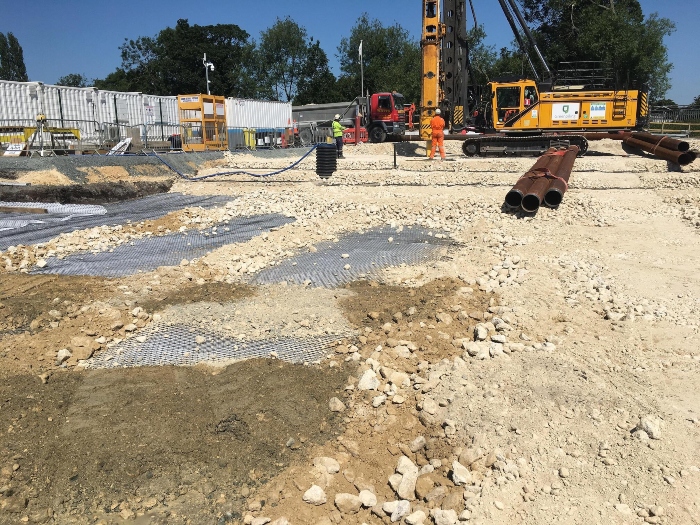Geosynthetics support circular economy by helping to reuse and recycle waste materials, and by reducing the carbon footprint of sites

The circular economy is an essential response to the growing scarcity and cost of natural resources, and the impacts of resource extraction, such as environmental degradation, biodiversity loss and harm to human wellbeing.
The circular approach aims to design out waste and pollution, keep products and materials in use, and regenerate natural systems.
Geosynthetics allow us to follow circular principles and good use of recycled and reused materials to deliver wider sustainability benefits. Typically, these materials include:
- Waste from mining activity
- Used consumer products such as plastic bottles and vehicle tires
Geosynthetics and construction, demolition and mining waste
Every year, we generate more than 10 billion tons (9.1 billion tonnes) of waste from construction and demolition, much of which ends up in landfills. Mining produces 200 billion tons (181.4 billion tonnes) of waste annually, which also goes to landfills or is piled up in unsightly slag heaps.
Combined with geosynthetics we can:
- Reuse CDW as infill to construct unpaved roads on soft ground, reducing waste in landfills and the need for quarried stone.
- Construct more stable slopes, for example, in railway cuttings, using a geosynthetic/CDW system.
- Create a subballast layer for railways by blending geosynthetics with fine mining waste mixed with local soils. This increases track stiffness, reduces maintenance and cuts demand for quarried ballast.
Geosynthetics and consumer waste
Each year hundreds of millions of tires are manufactured. After use they are often discarded in stockpiles that are prone to fire, releasing toxic fumes. And many of the one million plastic bottles sold every minute end up in our waterways and oceans. Both these waste materials have valuable qualities that can be unlocked with geosynthetics.
Geosynthetics can:
- Be used alongside waste tires or compressed plastic bottles to form drainage systems in landfill sites, where these materials are already abundant. Testing shows a greater discharge capacity compared to traditional gravel layers.
- Be used with baled tires to construct river flood defenses.
- Be used to build infiltration trenches that reduce flood risk in urban areas when used with plastic bottles.
Geosynthetics in the recycling economy
Geosynthetic products can be made from recycled materials. For example:
- Waste tires can be converted into rubber grains and used to manufacture geosynthetics, with savings in the use of bentonite, which would otherwise have to be mined and transported in bulk.
- Geosynthetics products designed to strengthen road asphalt and extend road lifetimes can be manufactured from 100%-recycled plastic originating from bottles.
And such geosynthetics products can themselves be recycled at the end of their useful life, typically through milling and remanufacture.
Responsible reuse
The geosynthetics industry is playing an ever-bigger role in making use of valuable materials that would otherwise be wasted and disposed of carelessly.
We recognize that waste materials will degrade with time and may contain substances that can cause ground contamination. Responsible reuse and recycling therefore require careful evaluation, design and thorough testing, to ensure we capture all the benefits of circular practices, without incurring harm.
Find out more about how geosynthetics are making a difference by downloading the International Geosynthetics Society (IGS) geosynthetics sustainability ebook or by visiting the IGS sustainability page.
This article first appeared on the IGS website.
 TEXTILES.ORG
TEXTILES.ORG


